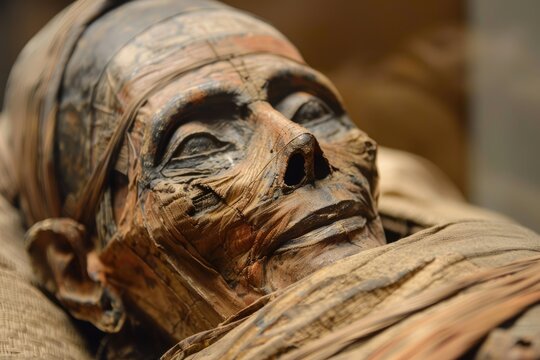Egyptian mummies stand as some of the most intriguing remnants of the ancient world, offering an unparalleled glimpse into the spiritual and cultural richness of one of history’s most enduring civilizations. Central to the Egyptians’ beliefs about the afterlife, the mummification process involved intricate rituals aimed at preserving the body for eternity. This sacred practice was not only designed to ensure the soul’s recognition in the next world but also to allow it to continue its journey through the afterlife, ultimately achieving immortality.
Mummification was a meticulous and highly skilled process, beginning with the careful removal of internal organs that were prone to rapid decay. These organs—stomach, lungs, liver, and intestines—were preserved separately in canopic jars, ensuring the essence of the deceased remained intact. The heart, believed to be the seat of the soul and intelligence, was often left within the body or specially preserved. This initial stage of mummification set the foundation for the enduring preservation of the body.

Following the removal of the organs, the body was dehydrated using natron, a naturally occurring salt mixture. This substance effectively absorbed moisture and inhibited bacterial growth, halting decomposition. This dehydration process, which lasted up to 40 days, transformed the body into a dry, resilient form. Afterward, the body was wrapped in layers of linen bandages, frequently interspersed with amulets and protective charms. These symbolic items were intended to shield the deceased from dangers in the afterlife and to guide them safely to the next world.
The preservation of the body was of paramount importance to the ancient Egyptians due to their beliefs surrounding the afterlife. They viewed the body, or ka, as an essential vessel for the soul’s return after death. By maintaining the integrity of the body, mummification ensured that the soul could recognize its earthly form and continue its existence in the afterlife. This belief in immortality was central to Egyptian culture, profoundly influencing their religious practices and burial customs.
In addition to the ka, the Egyptians believed in other aspects of the soul, such as the ba, which could travel between the living and the dead, and the akh, a transformed spirit capable of enjoying an eternal afterlife. The complex spiritual concepts underpinning their beliefs were reflected in the elaborate rituals surrounding mummification, each step meticulously crafted to ensure the soul’s harmonious transition to the presence of the gods.
After the mummification process, the body was placed in a coffin, often made of wood and adorned with intricate designs. These coffins served as portals for the soul, with images and inscriptions offering guidance through the afterlife. The tomb itself was also filled with items meant to assist the deceased, including food, clothing, jewelry, and protective amulets. Such offerings were believed to provide comfort and sustenance in the afterlife, reflecting the Egyptians’ commitment to ensuring the well-being of the departed.
For individuals of high status, such as pharaohs, the mummification process and burial rites were even more elaborate. Pharaohs were frequently buried in multiple coffins, sometimes housed within ornate sarcophagi made of stone. Their tombs, located in places like the Valley of the Kings, were filled with treasures such as gold, jewelry, statues, and intricately carved wall art. These burial chambers were not only designed to honor the deceased but also to prepare them for an eternal reign in the afterlife as divine beings. The grandeur of these tombs underscored the pharaohs’ status as intermediaries between the gods and their people.
Royal tombs and those of high-ranking officials were often designed to replicate the lives the deceased had led on Earth. The walls of these burial chambers were adorned with vivid murals depicting scenes from the afterlife, with gods and divine beings offering protection and guidance. To safeguard the tombs from robbers, they were carefully sealed and hidden. Despite the frequent looting of many royal tombs over the centuries, their enduring magnificence continues to provide insight into the aspirations and spiritual beliefs of ancient Egyptian elites.
Pharaohs were often buried with symbolic items to assist them in the trials of the afterlife. Chariots, boats, weapons, and other tools were placed in their tombs to ensure they were well-equipped for their eternal journey. This attention to detail underscores the Egyptians’ belief that the afterlife was a continuation of life on Earth, where the deceased needed to be fully prepared for their new existence.
The enduring legacy of Egyptian mummification continues to captivate modern audiences. The preservation of these bodies, some of which have remained remarkably intact for over 3,000 years, offers invaluable insights into the religious and cultural practices of one of history’s most advanced civilizations. Far from being merely a method of preservation, the art of mummification serves as a profound reflection of the Egyptians’ intricate beliefs about life, death, and the afterlife.
Artifacts and tombs from ancient Egypt provide a window into the sophisticated spiritual practices that were central to their society. Through the preservation of the body and its preparation for the journey to the afterlife, the Egyptians sought to ensure the soul’s continued existence in harmony with the gods, achieving immortality in the world beyond. Today, these practices continue to fascinate scholars and historians, deepening our understanding of ancient Egyptian life and beliefs.
The embalming techniques, the symbolism embedded in tombs, and the treasures discovered within royal burial sites remain a testament to a civilization’s quest to conquer death. These discoveries tell the story of a society that viewed the afterlife as a continuation of earthly life, with the same needs, desires, and aspirations. The legacy of Egyptian mummification endures, inviting us to marvel at the ingenuity and spiritual depth of this ancient culture.





